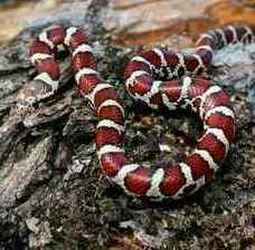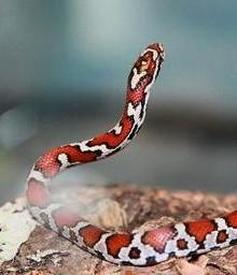Milk snakeLampropeltis triangulum |

Custom Search
|
|
The milk snake or milksnake (Lampropeltis triangulum) is a species of King snake endemic to North America. Both King snakes such as California Kingsnake (Lampropeltis getula californiae) the and Milk snakes belong to the genus Lampropeltis. With 24 subspecies there is quite a variation among them, and many are known by their own common names.
Some scientists believe that the species may, in fact, be split into several separate species in the future. Milk snakes aren't venomous unlike other venomous snakes species found in their habitat. The milk snake many subspecies are found in a very wide range that extends from southeastern Canada on Ontario and Quebec, southward through most of the USA with the exception of the west coast. Their range extends even further south throughout Mexico and Central America as far south as northern Venezuela and western Ecuador in northern South America. That's why the milk snake has the widest geographic range of any snake species found in North America. Many of the milk snakes subspecies are popular choices for pet snakes, mostly because they do very well in captivity, have a good temperament, aren't too big and are certainly beautiful snakes found in a wide range of colors. In the wild, it's impossible to know their lifespan but in captivity usually, they live around 12 years but have lived as long as 22 years. Normally these snakes have smooth and shiny scales with a typical pattern of alternating bands in various colors such as white, black and red or red, black and yellow. In some populations, the traditional bands are substituted by red blotches. Some milk snakes are strikingly similar in appearance to the deadly coral snake, this type of mimicry is known as Batesian mimicry, and is used most likely to scare away potential predators. But even though the harmless milk snakes and the venomous coral snake both display transverse bands of red, black and yellow some simple mnemonics (see below) are used to distinguish between the two.
Just like their appearance their size also varies among subspecies, ranging normally from 20 to 60 inches (51 to 152 cm) but the largest subspecies the Black milk snake may reach 84 inches (213 cm). Subspecies / Taxonomy / Etymology
The species genus "Lampropeltis", derives from the Greek, and means "shiny shields" which is quite suitable for these snakes, known for their well-defined and glossy scales. In the past, the scarlet kingsnake (Lampropeltis elapsoides), was classified as a subspecies of milk snake but by 2006 it was reclassified and is now considered a distinct species. There are 24 subspecies of milk snakes currently recognized here some of the more popular in the pet trade. Eastern milk snake (L. t. triangulum - Lacépède, 1788) These snakes are commonly found throughout much of the Northeastern United States, their range extends form from Maine and to Minnesota and Iowa, and as far south as northern Georgia. They are also found on Ontario in Canada. Unlike other milk snake subspecies they are most often confused with the venomous copperhead (Agkistrodon contortrix) not with coral snakes.They among the most popular snakes kept as pets and therefore are very often bred in captivity. Find more about them here. Honduran milk snake (L. t. hondurensis - K.L. Williams, 1978) These snakes grow to about 48 inches long (120 cm) and have a bright reddish coloration with black and yellow or orange stripes. The Honduran milk snake is are found in the Southwestern United States, Honduras, Nicaragua, and Costa Rica. These milk snakes are very popular pets and several color morphs have been bred in captivity. Find more about these snakes here. Red milk snake (L. t. syspila - Cope, 1889) Found in some regions of the American South and Midwest, including Missouri, Kansas, southwest Indiana, southern Illinois, Kentucky, Iowa, west Tennessee and north Arkansas. Even thought they are nonvenomous and not dangerous to humans it's very often confused with the highly venomous coral snake. But unlike those they have a white, yellow or tan body with reddish bands or blotches with black rims, which means that the popular rhyme "red touch black, friend of Jack," is true. These are are relatively small snakes averaging between 21 and 36 inches in total length (53 to 91 cm). Although not as popular sometimes Red milk snakes are kept as pets. Pueblan milk snake (L. t. campbelli - Quinn, 1983) The species common name "Pueblan" derive from the fact that they are native to southern Puebla, Morelos and Oaxaca in Mexico. But they are sometimes also called Campbell's milk snakes. They have a banded appearance, with red, black and white bands, and grow to be about 30 inches (76 cm). Like other milk snake subspecies they are commonly confused with coral snakes. The Pueblan milk snake is a popular pet snake with other color morphs being bred in captivity. List of other milk snake subspecies: Guatemalan milk snake (L. t. abnorma - Bocourt, 1886) Louisiana milk snake (L. t. amaura - Cope, 1861) Andean milk snake (L. t. andesiana - K.L. Williams, 1978) Mexican milk snake (L. t. annulata - Kennicott, 1861) Jalisco milk snake, L. t. arcifera (Werner, 1903) Blanchard's milk snake (L. t. blanchardi - Stuart, 1935) New Mexico milk snake (L. t. celaenops - Stejneger, 1903) Conant's milk snake, (L. t. conanti - K.L. Williams, 1978) Dixon's milk snake, (L. t. dixoni - Quinn, 1983) Black milk snake, (L. t. gaigeae - Dunn, 1937) Central Plains milk snake (L. t. gentilis - Baird & Girard, 1853) Ecuadoran milk snake (L. t. micropholis (Cope, 1860) Pale milk snake (L. t. multistriata - Kennicott, 1861) Nelson's milk snake (L. t. nelsoni - Blanchard, 1920) Pacific Central American milk snake (L. t. oligozona - Bocourt, 1886) Atlantic Central American milk snake (L. t. polyzona - Cope, 1861) Sinaloan milk snake (L. t. sinaloae - K.L. Williams, 1978) Smith's milk snake (L. t. smithi - K.L. Williams, 1978) Stuart's milk snake (L. t. stuarti - K.L. Williams, 1978) Utah milk snake (L. t. taylori - W.W. Tanner & Loomis, 1957) Diet / Feeding The Milk snake is a carnivore like all other snakes, they feed on a wide variety of prey. Juvenile and smaller milk snakes usually eat smaller prey such as insects, slugs, crickets, and earthworms. While adult snakes feed on small mammals, birds, bird and snake eggs, lizards (particularly skinks), frogs, fish. Occasionally they even feed on other snakes including their lookalike the highly dangerous coral snake. They provide humans a valuable service since many of their prey as adults includes rats, mice, voles and other rodents commonly found in agricultural areas and considered pests. The Milk snake is a much more opportunistic hunter when compared with other species such as the Corn snake (Pantherophis guttatus) or even fox snakes. These are powerful constrictors, to kill their prey they wrap their body tightly around the victim and stop the blood flow through the heart. Once the animal is dead they swallow it whole like all other snakes. Reproduction The Milk snake is an oviparous species, meaning that these snakes lay eggs. The milk snake mating season runs from March or early May to late June depending on the subspecies and geographic region. They start breeding soon after leaving brumation, although they will sometimes mate using their winter dens. Females leave a pheromone trail once they begin to ovulate so males can follow these trails and find females. The copulation may last for several hours, probably to prevent other males from mating with that ovulating female. The clutch size ranges from 2 to 24 eggs, with an average of about 10 eggs, the number of eggs varies by region and subspecies. Females lay the eggs about 30 days after copulation usually in June or July.The eggs are laid beneath boards, logs, rocks, rotting vegetation or buried in soil, and once laid there's no further parental care given to them. These warm and humid places help with the incubation of the eggs which lasts for one or two months, and usually, they hatch in August or September. The hatchlings which are around 6 or 7 inches long are more brightly colored than adults, their coloration becomes duller as they mature. The Milk snake reaches sexual maturity at the age of 3 or 4 years. Conservation / Threats The milk snake as a species is not listed on the IUCN red list only the Ecuadorian milk snake (Lampropeltis triangulum micropholis) as been assessed as a Least Concern species. But like so many other snake species they face some threats from habitat destruction and degradation, prosecution due to their similarity to other venomous snakes. Some pressure due to the collection from the wild for the pet trade also takes its toll.
|
Scientific classification |
© 2014 Snake Facts About Us | Privacy Policy | Contact




